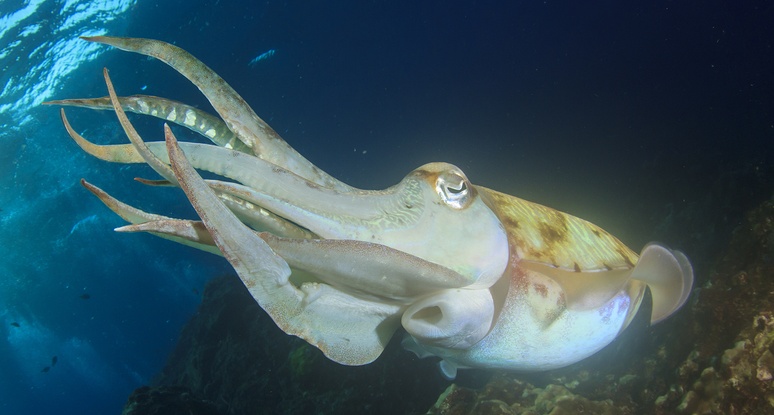Know Your Remedies: Sepia Officinalis (Sep.)
 Common Names: Common cuttlefish; European cuttlefish.
Common Names: Common cuttlefish; European cuttlefish.
General Information
Sepia is considered a main remedy for women but men and children also need it at times. While children may be lively and excitable, adults are inclined to weariness, indifference, hardness, and irritability. These physical and mental-emotional symptoms surprisingly improve with vigorous exercise. The person feels chilly, craves chocolate and sour things such as vinegar but dislikes fats, and consolation or sympathy. Symptoms generally improve in the evening, and milky discharges are common (mucus, vomit, urine, vaginal.) Mental-emotional Symptoms
- Absent minded and forgetful. Dull, difficult thinking.
- Lack of attachment and inability to feel love. Aversion to family members.
- Irritability and easily angered. Want to be left alone.
- Sarcastic, cutting comments, often followed by guilt and remorse.
- Feel better when occupied. Mothers often prefer work outside the home.
- Symptoms worse before, during, and after menstruation
- Aversion to sexual intercourse. May feel guilty about their lack of interest.
Headache
- Left-sided headaches, especially over the left eye.
- Heaviness or drooping of eyelids during headache.
Menstrual / Menopausal Problems
- Premenstrual syndrome.
- Periods early, scanty, heavy, or painful.
- Bearing down sensation with menstruation.
- Hot flushes during menopause.
Skin Problems
- Types of psoriasis
Urogenital and Gynaecological Problems
- Stress incontinence (leakage of urine) with exertion, cough, sneeze, or laughter.
- Types of genital herpes and warts.
- Vaginitis with a white, milky discharge that causes itching.
- Prolapse of the uterus with a bearing down sensation.
- Infertility or tendency to miscarriage.
Gastrointestinal Problems
- Empty feeling in stomach, even after eating.
- Nausea and vomiting when pregnant – worsened by food odors.
- Cracking of lips at the bottom centre or at the corners.
- Sensation of a lump in the rectum
For Pets
- Disinterest in surroundings, offspring, or companion animals.
- Thrush, prolapse, or infertility.
Where do I find it?
Sepia Officinalis (Sep.) is available from our online store as a single remedy, and as part of the following Complexes (combination remedies): Fatigue – Physical; Nausea.
Home Treatment Guidelines
Acute, Self-Limiting Conditions
Conditions like colds or minor injuries, which are short-term and typically improve on their own, can be managed at home with homeopathy. However, in emergencies or if symptoms worsen, contact your healthcare provider.
Chronic Conditions
These home treatment instructions do not apply for ongoing issues, whether mentioned above or not, like persistent allergies or chronic pain. You should consult a qualified homeopath for a personalized treatment plan to achieve the best results with homeopathy for chronic conditions.
How to Take the Remedy for Acute Conditions
- Take one pill or five drops of the remedy. The frequency depends on symptom severity. As examples:
- For life-threatening symptoms, take every 1 minute and seek emergency help immediately.
- For mild symptoms, take every 4 hours.
- Stop taking the remedy once you feel better. Resume if symptoms return.
- If no improvement after four doses, choose a different remedy or consult a professional homeopath.
- For more details on dosing, refer to: How Often to Dose with a 30C Homeopathic remedy.
- For information on the different potencies, read: Guidelines on which potency to use
Additional Notes From Past Masters
Homeopathy is a 200-year-old system of medicine. Early homeopaths recorded detailed notes on how remedies worked, including initial tests, remedy relationships, and their experiences. These writings were shared to improve homeopathic practice and now offer fascinating insights into past uses of homeopathy. Here’s an example, edited and modernised for clarity, from Leaders In Homoeopathic Therapeutics (1898) by E. B. NASH M.D.:
Leaders In Homoeopathic Therapeutics by E. B. Nash M.D.
Sepia Officinalis (Sep.
Bearing down pains, must sit close and cross her legs to keep something from coming down out of the vagina. Sense of fullness in the pelvic organs, and pressure down into the anus, as if a ball or weight; oozing of moisture. Flushes of heat and perspiration at the climacteric. Painful sense of emptiness or goneness at the pit of the stomach. General relaxation, weak, faints while kneeling at church; falling womb and pelvic organs; drooping eyelids, weak back < on walking. Cachectic, yellow face, with yellow saddle across face and nose; moth patches; ringworms. Modalities: < standing, mental labor, sexual excess, jar, after sleep, laundry work; milk (diarrhoea), climacteric kneeling at church, > sitting with legs crossed, loosening clothes, open air. Sensation of a ball in inner parts; during menses, pregnancy, lactation, great sadness and weeping. Dread of being alone; of meeting friends, indifferent, even to one’s family, to one’s occupation; to those whom she loves. Headache: in terrific shocks; pressing, bursting < motion, stooping mental labor, > by pressure, continued fast motion. Urine: deposits a reddish clay sediment, which adheres to the vessel; fetid, offensive, must be removed from room. Enuresis: bed wet almost as soon as the child goes to sleep; during first sleep, violent stitches upward in the vagina. Dyspnoea; < sitting, after sleep, in room, > dancing or walking rapidly. * * * * * This is another of our wonderful remedies of which the dominant school knows nothing, except they have learned it from us. Its chief sphere of action seems to be in the abdomen and pelvis, especially in women. No remedy produces stronger symptoms here. We quote from different but equally good observers. “Sensation of bearing down in the pelvic region, with dragging pains from the sacrum; or feeling of bearing down of all the pelvic organs.” (Hahnemann). “Labour-like pains accompanied with a feeling as though she must cross her legs and ‘sit close’ too keep something from coming out through the vagina.” (Guernsey). “Pain in uterus, bearing down, comes from back to abdomen, causing oppression of breathing; crosses limbs to prevent protrusion of parts.”(Hering). “Prolapsus of the uterus, of the vagina, with pressure as if everything would protrude.” (Lippe). “Experience has shown its value in cases of ulceration and congestion of the os and cervix uteri. Its use supercedes all local applications.” (Dunham). No higher authority than the united testimony of these five of our best observers could be brought to show the action of Sepia upon the pelvic organs. Now when we come to examine the provings in Allen’s Encyclopaedia, we find that these symptoms were mainly produced by Hahnemann and his provers, and Hahnemann advocated proving remedies in the 30th, and some of them were produced by the 200th, especially those most strongly verified by black-faced type. We confess that we cannot understand how so many question the value of potencies for proving or curing, and most of all do we wonder at Dr. T. F. Allen himself “going back” on potencies above the 12th. Such a course looks very much to us like “kicking against the pricks” or, in other words, trying to fight the truth. But we must be charitable. Sepia, like Sulphur, affects the general circulation in a very marked manner. Flashes of heat with perspiration and faintness is almost as characteristic of this remedy as of Sulphur. But there are, with Sepia, more apt to be associated with them the pelvic symptoms already given, and they are also more apt to occur in connection with the climacteric. Indeed, these flashes often seem with Sepia to start in the pelvic organs and from thence to spread over the body. But this irregularity of circulation extends as far as that of Sulphur. The hands and feet are hot alternately, that is, if the feet are hot, the hands are cold, and vice versa. There is not so much sensation of burning with Sepia as with Sulphur, but there is actual heat, and the venous congestion, which seems to be the real state of the organs where the pressive bearing down et cetera is left, is also accompanied with much throbbing and beating. This local congestion to the pelvic organs is not simply sensational. There are actual displacement in consequence of it, and the long continued congestion results in inflammations, ulcerations, leucorrhoeas and even malignant or cancerous disorganizations. Induration with a painful sense of stiffness in the uterine region is characteristic. This pelvic congestion also affects the rectum in a marked degree. The rectum prolapses, there is a sensation of fullness, or of a foreign substance as of a ball or weight, and oozing of moisture from the rectum. Indeed, the rectal and anal symptoms are almost as strong as the uterine and vaginal. It is impossible to enumerate all the symptoms connected with the circulatory disturbances of Sepia in such a work as this, only a general study of the Materia Medica can do it. The urinary organs come in for their share of symptoms. The same pressure and fullness consequent upon the portal congestion reaches here. We will now proceed to give what we have found to be particularly valuable symptoms under the various organs in this region, “Pressure on bladder and frequent micturition with tension in lower abdomen.” “Sediment in the urine like clay; as if clay was burnt on the bottom of the vessel; urine very offensive (Indium), can’t endure to have it in the room, it is reddish or may be bloody.” This is found mostly with women. With children there is one peculiar symptom which has often been verified. “The child always wets the bed during its first sleep.” Upon the male organs I have found it particularly useful in chronic gleet. There is not much discharge, but a few drops, perhaps, which glue up the orifice of the urethra in the morning; but it is so persistent and the usual remedies will not “dry it up.” In my early practice I used to use a weak injection of Sulphate of Zinc, but it used to annoy me that I could not do it without resorting to local measures. Sepia does it in the majority of cases and Kali iodatum will do it in the rest. I have, where there was a thick discharge of long standing and the smarting and burning on urinating continued, several times finished the case with Capsicum. As a rule, this long continued slight, passive gleety discharge is a result of weakness of the male genitals, as is shown by a flaccidity of the organs and frequent seminal emissions. The emissions are thin and watery. Sepia covers all of this and often sets all to rights in a short time. The mental symptoms of Sepia are like Pulsatilla, in that she is sad and cries frequently without knowing the reason why. So if in a tearful mind with uterine disturbances Pulsatilla should fail you, the next remedy to be studied is Sepia. But there is another condition of mind not found under Pulsatilla or any other remedy in the same degree, and that is, that, notwithstanding there is no sign of dementia from actual brain lesion, the patient, contrary to her usual habit, becomes indifferent to her occupation, her house work, her family or their comfort, even to those whom she loves the best. This a very peculiar symptom and a genuine keynote for the exhibition of Sepia. Upon the head Sepia is one of our best remedies in hemicrania of women of the Sepia temperament, and who are suffering from uterine trouble which we have already described. Another peculiar headache is, that the pain comes in terrific shocks, so as to jerk the head in spite of the patient. There are three remedies that have prominently drooping eyelids (Causticum, Gelsemium and Sepia). of course, the other symptoms must decide which is the one indicated in the case at hand. So far as the nose is concerned Sepia is often of use in chronic catarrh. I had a case in which the discharge was thick, bland and in large quantities. Pulsatilla would relieve the catarrhal trouble but would, at the same time, increase the menstrual flow too much, but Sepia cured both. The chronic will sometimes have to be made between Kali bichromicum and Sepia in these chronic catarrhs, but it is generally easy, although the local symptoms are much alike. “Yellow saddle across upper part of cheeks and nose, and yellow spots on the face,” is a characteristic of great value, but the yellowness and yellow spots do not always stop here. You may find them in abundance on the abdomen. The whole surface of the body may be yellow like jaundice. The face of the Sepia patient is the most “tell tale” face I know, and if you find it upon a woman you may always find her leading symptoms in connection with her menstrual and uterine functions. There is one symptom of Sepia upon the stomach that is also very characteristic, viz., a “painful sensation of emptiness, goneness or faintness.” The patient will call it an “all gone” feeling. Of course you remember that Ignatia and Hydrastis Canadensis have this symptom very strongly. Other remedies also have it in more or less marked degree but none so strongly in connection with uterine symptoms as Sepia, unless perhaps it be Murex purpurea, and you will not often have much difficulty in choosing between these last two if you carefully examine all the symptoms. I have often thought that this symptom, so persistent and severe, might be due to the actual emptying of the upper abdomen by the prolapsed womb, dragging everything after itself into the pelvic cavity. It is so in Stannum and Lilium tigrinum, and the weakness of the natural supports (ligaments) of the uterus being remedied (not supplanted by the pessaries and artificial supports of various kinds) the distressing symptoms disappear. Vomiting in pregnancy with this “all gone” feeling is often cured by Sepia; also the thought or smell (Colch.) of food sickens her. I mentioned the “sense of weight or a ball in the rectum” when writing of the pelvic congestion of Sepia. This sensation is not relieved by stool. Sepia is a remedy for constipation, and that of a very obstinate character. Like Selenium it has great straining; but manual aid is necessary to accomplish the stool. This is mostly in children. I once cured a very obstinate case of entero-colitis (so-called cholera infantum), after the complete failure of two eminent allopaths, with Sepia, the leading symptom being, “always worse after taking milk.” Oozing of moisture from the anus finds its remedy here sometimes, but oftener in Antimonium crudum. The Sepia patient is very weak. “A short walk fatigues her very much.” She faints easily from extremes of cold or heat, after getting wet, from riding in a carriage, while kneeling at church, and on other trifling occasions. This fainting, or sense of sinking faintness, may be found in pregnancy, child bed, or during lactation; or, again, it may come on after hard work, such as “laundry work;” so it has come to be called the “washer woman’s” remedy. Phosphorus have washer woman’s toothache. SKIN. “Itching often changes to burning when scratching” (Sulph.) “Soreness of skin; humid places in bend of knees.” “Brown spots in face, chest, abdomen; chloasma” Herpes circinates “Large suppurating pustules constantly renewing themselves.” “Acarus itch, pruritus; tettery eruptions, etc.” Sepia, like Sulphur, has many forms of eruption on the skin, and indeed there is great general resemblance between these two antipsorics. They follow each other well. Of course that is always providing they are indicated by the symptoms, which is often the case. I do not believe in the so-called incompatibles as some do. I should give Causticum after Phosphorus, Silicea after Mercury, or Rhus tox. after Apis mel. if I found them indicated.







